Mister Bear Takes A Look At Gold, Silver & The Dow Jones
Monday's declines in gold and silver were annoying, but nothing has changed in the gold and silver markets during the past year. Well that's not true; in the past year central banks have entered the gold market to purchase real gold. Strange, but people in the banking system who want gold always seem to choose actual gold instead of taking advantage of the GLD ETF. In the silver market, the lawsuit against JP Morgan for allegations of manipulating the silver market with "uneconomic short sales" at the COMEX is advancing in the court system. These are major developments in the precious metals markets.
Looking at gold with the Bear's Eye View from its credit crisis lows of October 2008, we see how the "policy makers" have yet to take gold below its 7% decline from its last closing high of the move ($1888.70 = our last BEV Zero) seen on August 22. Yesterday (Monday, 19 Sept) gold closed at $1776.40, only 5.95% from its last post October 2008 high. If gold were to correct 14%, as it has done twice since October 2008, the "policy makers" would have to take gold down to $1632. That might be hard for them to accomplish.
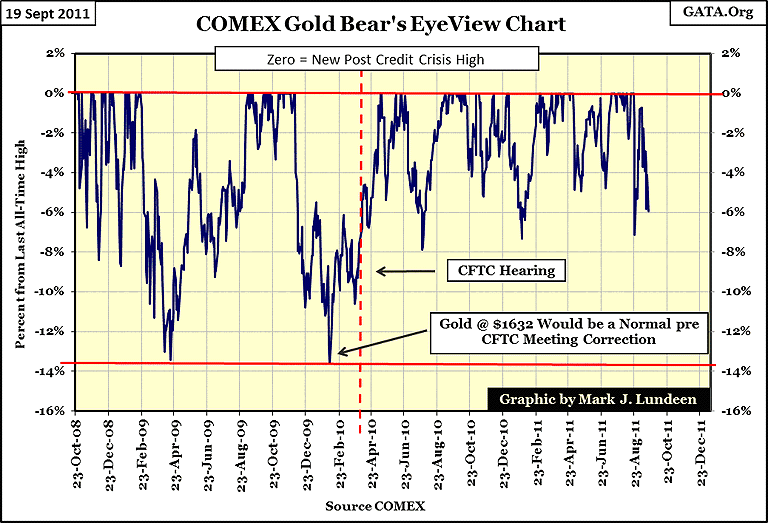
But gold at $1632 would be nothing major in our current bull market. Using a BEV plot starting at the absolute low of the 1980-1999 bear market (where gold closed at $253.70 an ounce on 19 July 1999), please note that in the following twelve years, gold has seen three +20% corrections without derailing its bull market. For your information, from gold's current last high of the move ($1888.70), a 20% correction would take gold down to $1510.
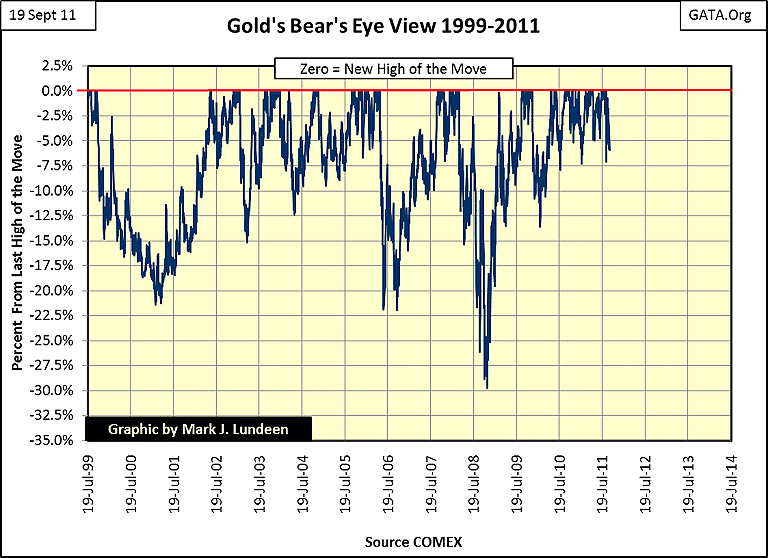
Seeing gold descend to $1632 (or $1510) would be quite a shock, but we need to keep in mind that as gold goes higher, it takes an increasingly larger dollar decline to see similar percentage decline in the price of gold.
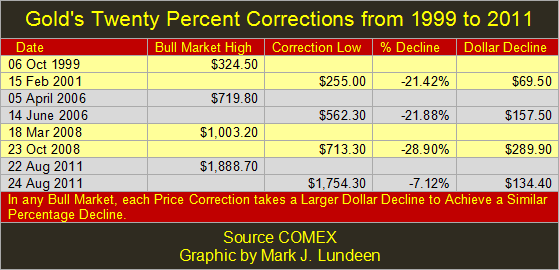
Looking at Gold's 1999-2011 BEV plot, and the table above showing the three 20% corrections seen in the price of gold over the past twelve years. Note how the first 20% correction occurred from October 1999, to February 2001, with gold correcting 21.39% on a price decline of only $69.50!
One of the many virtues of the Bear's Eye View market analysis is that prices don't matter; only percentage declines from past new-highs of the move do. As the table above makes very clear, as the bull market takes gold to ever higher prices, a $69.40 decline will mean less and less over time. Our current correction bottomed at 7.12%, as gold fell $134.40. Gold's last high of the move is $1888.70. So, a $134.40 drop isn't much, no matter what they say on CNBC! But the 21.42% correction seen in the first bull market decline hurts the same * every time *, no matter what the price of gold! To replicate the 1999-2001 correction today, gold would have to decline to $1483.
Since the CFTC silver market manipulation public meeting, a year and a half ago, the gold market has been more up than down. How unusual this has been can be seen when we look above at gold's BEV plot. Since June of 2010, gold has formed its largest cluster of BEV Zeros since 1999, with no declines deeper than 7.5%. Most unusual! This tells us how undervalued sub $2000 gold is! We'll know when gold once again approaches fair value, when gold once again sees 15% - 20% corrections in its BEV chart. That may be when gold is over $4000, with price declines of over $600!
Since July 1999, gold has seen significant volatility. No one likes it, but we should all expect future corrections of greater than 20% in the years to come. If gold should hit $5000, and it will, a decline of a $1000 will have the talking heads on CNBC pulling their hair out over the new "bear market" in gold. But gold's BEV plot above would record this supposed future $1000 decline from $5000 gold, as just another 20% correction in a multi-decade bull market.
Silver's BEV plot looks good too, with the lows of last summer still holding. I'm not a prophet, the future is a much a mystery to me as to anyone else. But I can say that the longer the lows of May 17 hold, the more difficult it will be for the big silver shorts to violate the lows of last summer.
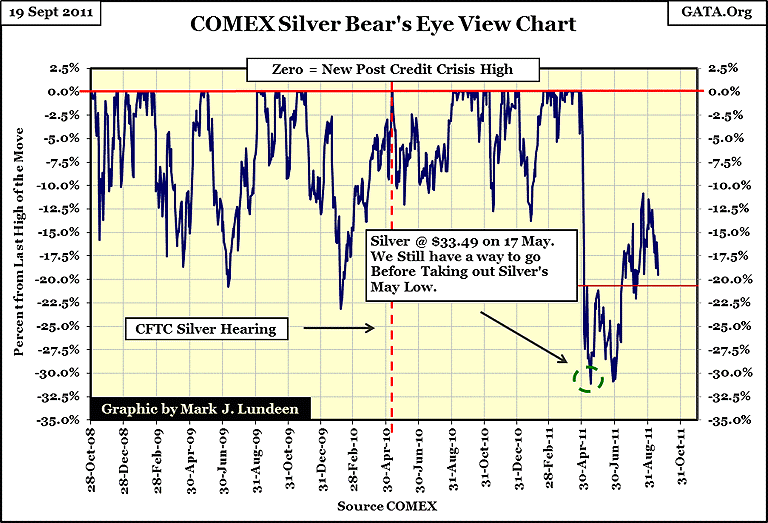
For those who like to see prices, here is a price chart for silver covering the same data as we see in the silver BEV plot above. In the chart below, I marked the start of the 03 Sept 2010 - April 2011's BEV cluster seen above. A nice +100% gain totally ignored by the BEV chart above. Remember: all new-highs of the move are the same to Mr Bear - A BIG FAT ZERO! Mr Bear is only interested in how large a percentage of the bull's gains he can claw back from them. One must just accept that significant gains above previous BEV Zeros will be ignored in a BEV plot. Note below how the -30% correction of May 17 is actually many dollars higher than the first new-high of the move last September. Not that Mr Bear cares about that.
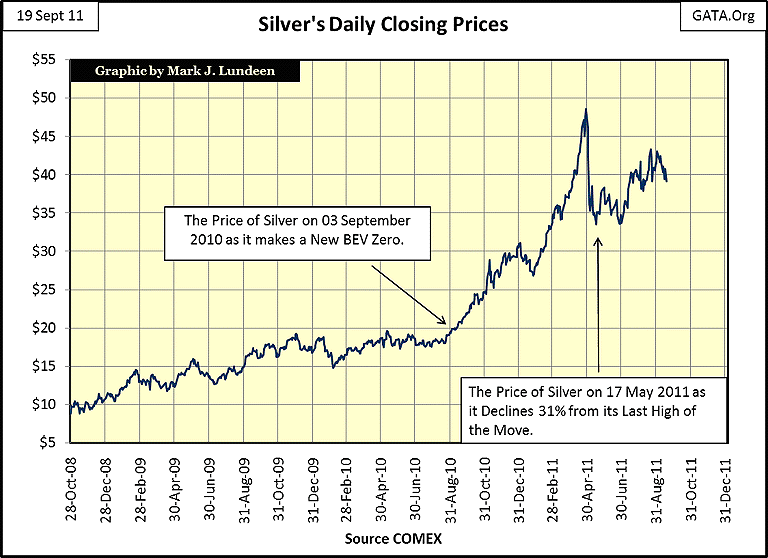
Next is a BEV plot for silver beginning at the bottom of its 1980-2001 bear market. So far, silver is acting exactly as it has for the past ten years. The +30% correction we saw in May is nothing unusual. Since 2001, silver has seen three days when it was at a new high of the move (BEV Zero), then a week or two later, it fell off a cliff with a 30% decline. Sure the big NY banks are doing this, but after ten years, silver has advanced relentlessly all the same, as we see in the price chart above.
In every case where silver saw a +30% correction, it didn't make a new-high of the move for well over a year after it hit bottom. That means that if silver doesn't make a new high until sometime after May 2012, it's following the established pattern of the past 10 years.
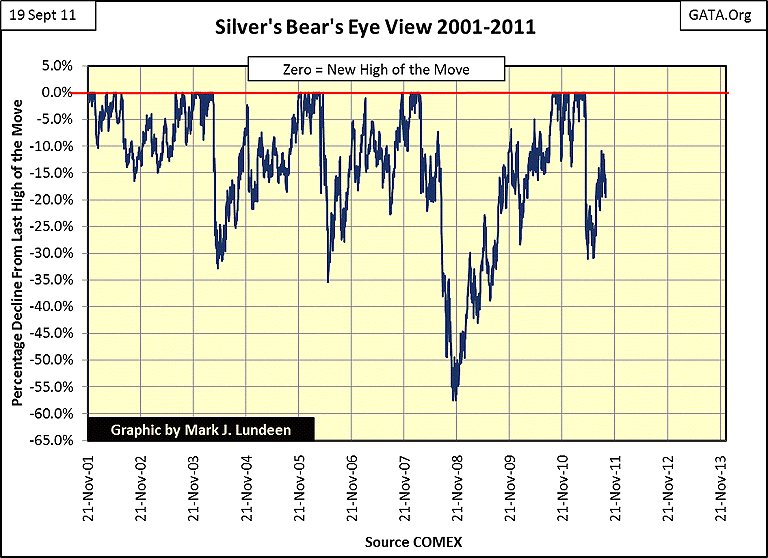
BUT, if silver does make a new-high of the move by January 2012, taking the BEV plot up to the 0% red-line, that would be a very bullish signal that silver is growing stronger, while the big banks who are sitting on the price of silver are growing weaker. Will silver make a new BEV Zero before New Year? I think it will, but like you, I'll have to wait to see what does actually happen.
Here is the Dow's post credit crisis bottom BEV Chart. Nothing terminal is apparent below, but there are warning signs I'd like to note. Early last summer, the Dow twice attempted to make a new BEV Zero, but failed to do so. These failures stand out in the chart below. Heck, all the Dow had to do was have a daily move of less than 1% to get the job done on both occasions, but even with all the king's horses, and all the king's men helping the Dow get back up to its BEV Zero red-line, it could not do it.
Failing to make new highs of the move (twice), the Dow Jones then fell to a new correction low, by doubling down its early summer losses in August.
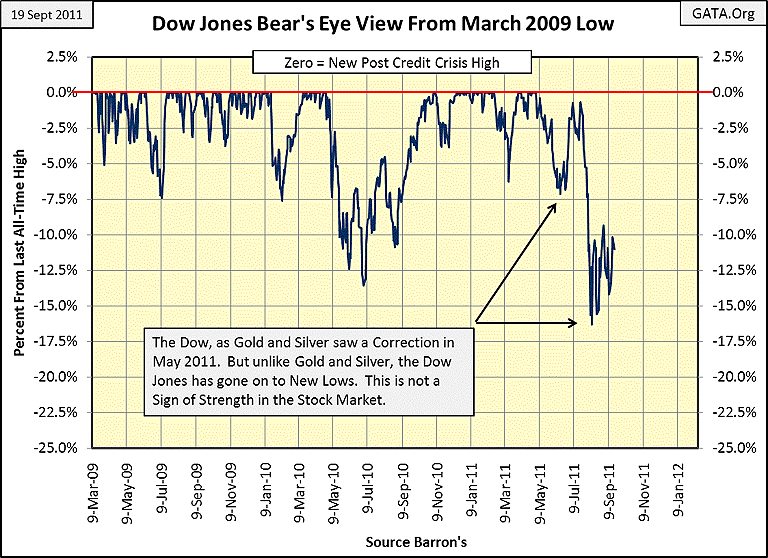
All and all, none of this is fatal to the Dow Jones Bulls. But what really bugs me about the stock market is that since July 25, the NYSE stopped seeing more 52Wk highs than 52Wk lows. This is not just the 30 stocks in the Dow, but a metric that samples every stock trading at the NYSE. Sorry for the monster table below, but there wasn't another way of illustrating my point. Take a moment and study the NYSE H-L Net column, third column from the left, and compare it to the Dow's column (2nd column). Note that when the stock market is strong, the Dow (only 30 stocks) may see down days as more stocks on the NYSE see new 52Wk highs than lows. And then look at what happened after July 25.

Since July 25, there have been only NINE trading days at the NYSE with more 52Wk highs than lows, with THIRTY trading days seeing more 52Wk lows than highs. And as I've noted many times before, when this indicator sees a big spike on the opposite side of its 0% line, as we saw on August 08 in the table above, and in the chart below, it's a VERY STRONG indication that the primary trend of the stock market has reversed.
It's a safe assumption that for the next few years, most stocks trading at the NYSE will find it easier making new 52Wk lows than 52Wk highs. But that is always true in bear markets, as is Mr Bear's annoying habit of creating false-hope of a market turn around in the minds of investors as he goes about his work of setting the stock market up for further declines. Currently Mr Bear is using Greek debt for bull bait.
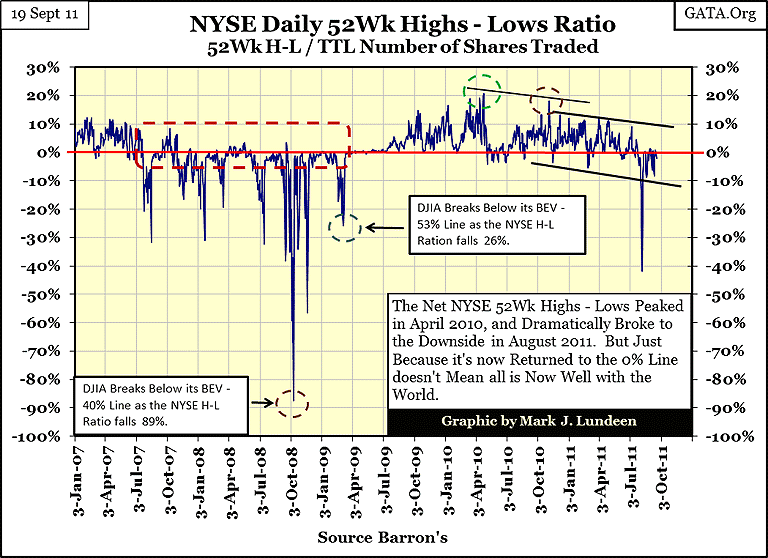
August 08's -40% breakdown in the NYSE 52Wk Highs-Lows data is a HUGE BEARISH FACTOR for the stock market, a positive indication that "liquidity" wants to flow away from the stock market, to seek more profitable opportunities elsewhere. Where might that be? It won't be Greek debt! A year from now, I suspect most people will wished that they had the foresight to have moved into gold, silver and mining shares in September 2011.
[email protected]
















